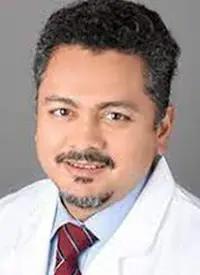Research Demonstrates the Importance of Effective Frontline Regimens for High-Risk Multiple Myeloma
Saad Z. Usmani, MD, MBA, FACP, discusses key points from his presentation at the 2023 SOHO Annual Meeting on frontline treatment of patients with high-risk myeloma, including the characteristics of patients with disease at high risk of recurrence, current treatment approaches, and ongoing research aiming to address unmet needs for this subset of patients.
Saad Z. Usmani, MD, MBA, FACP

Proper disease management is crucial for delivering optimal treatment outcomes to newly diagnosed patients with high-risk multiple myeloma, and further research is necessary to determine the most effective frontline treatment courses for patients at high risk of recurrence with a range of unique disease biologies, according to Saad Z. Usmani, MD, MBA, FACP.
“We are not going to have perfect, randomized phase 3 data to guide us, but we need to take care of our patients with the best available evidence,” Usmani said in an interview with OncLive® during the 2023 SOHO Annual Meeting.
In the interview, Usmani discussed key points from his SOHO presentation on frontline treatment for patients with high-risk myeloma, including the characteristics of patients with disease at high risk of recurrence, current treatment approaches, and ongoing research aiming to address unmet needs for this subset of patients.
Usmani is a hematologist-oncologist, myeloma specialist, and cellular therapist at Memorial Sloan Kettering Cancer Center in New York, New York.
OncLive: What was the goal of your presentation on the frontline treatment of patients with high-risk multiple myeloma?
Usmani: The question posed to me for the presentation was whether we have enough data to personalize our approach for patients with newly diagnosed, high-risk multiple myeloma. I sought to look at all the contemporary clinical trials we have and look at the high-risk patient population to try to come up with recommendations on how to [treat] high-risk patients differently than standard-risk patients.
What factors do you look for when identifying patients with high-risk multiple myeloma?
When we talk about high risk for newly diagnosed patients, [we mean] the risk of the disease coming back within the first 2 years of diagnosis despite giving the appropriate induction, transplant, consolidation, or maintenance treatments. The treatments we give influence that. The high-risk factors or definitions will likely change as we incorporate newer treatment strategies into the frontline setting.
That said, there are certain karyotype abnormalities, genetic abnormalities, and clinical features that portend a high risk of the disease coming back. For example, there are certain translocations, such as 4;14 14;16, and 14;20. Patients with extra copies of chromosome 1q21.1, primarily 4 or more copies, would be considered high risk. [Patients with] extramedullary myeloma, circulating plasma cells or plasma cell leukemia, or 17p deletions or p53 mutations, would be considered high risk. Some other [risk factors] are emerging, [such as] 1p32 deletion, and there are some common ones within the RAS family of genes.
How would you approach treatment for patients with newly diagnosed, high-risk multiple myeloma?
I made the case that quadruplet induction regimens should be employed for high-risk patients. Carfilzomib [Kyprolis], lenalidomide [Revlimid], and dexamethasone [KRd], or carfilzomib-based induction, perhaps has the best progression-free survival data. I also said that if we give a quadruplet with KRD—for example, daratumumab with KRd—we get a better depth of response and minimal residual disease [MRD] negativity for patients. Most of the data we have is nonrandomized. However, for patients who are coming to us, we need to be able to pick the best strategies for them, because our first shot is the best shot.
What unmet needs must still be addressed to improve outcomes and develop new treatment options for patients with high-risk disease?
Once we get patients into a deep response with initial induction therapy, with or without transplant depending on the patients’ age, comorbidities, etc., the maintenance strategy with a proteasome inhibitor and an immunomodulatory agent is what keeps things in check. We don’t take our foot off the pedal from maintenance therapy unless there is a tolerability issue or if the drugs are not working anymore. That whole strategy highlights the fact that there are certain disease biologies for which we do not have good therapeutic options.
This is where introducing BCMA- and GPRC5D-directed treatments into the schema may help us achieve those goals. The goal is to have sustained, deep MRD negativity for high-risk patients. These types of ideas will be explored in clinical trials.
Additionally, some small molecules may be of benefit, [such as] the newer cereblon E3 ligase modulators. Some therapeutics are being developed to target patients with translocation 4;14, as an example. Those are the areas of unmet need. [We should try] to make more personalized approaches for different biologic subsets of high-risk disease.
What is your main message for colleagues regarding the future of high-risk multiple myeloma management?
[Do not] under-treat patients with myeloma, especially those with high-risk disease. We need to do more to design clinical trials and ask different kinds of questions for high-risk disease compared with how we’ve done things in the past.
Clinicians referring a patient to MSK can do so by visiting msk.org/refer, emailing referapatient@mskcc.org, or by calling 833-315-2722.



